Clay Minerals and Sr-Nd Isotope Compositions of Core CG 1601 in the Northwest Pacific: Implications for Material Source and Rare Earth Elements Enrichments
Abstract
:1. Introduction
2. Regional Setting
3. Sample and Methods
3.1. Clay Minerals
3.2. Sr-Nd Isotopes
4. Results
4.1. Clay Minerals
4.2. Sr-Nd Isotopes
5. Discussion
5.1. Material Sources
5.1.1. Clay Mineral Indication
5.1.2. Sr-Nd Isotope Indications
5.2. Sedimentary Environment
5.3. Indication of the REY Enrichments
6. Conclusions
- (1)
- M/I (montmorillonite/illite) and the Sr-Nd isotopic characteristics indicate that the sediments in the study area are dominated by terrestrial materials. Considering that the study area is far away from the mainland and in the downwind direction of the East Asian monsoon, it is speculated that the terrigenous components of the sediments in the study area are likely to be East Asian dust.
- (2)
- The εNd of GC1601 is positively correlated with P2O5, Co, Ni, and Cu, and approaching εNd of seawater with increasing depth, indicating that the sedimentary environment in the area is relatively stable.
- (3)
- Most of the sediments in the study area are not highly enriched in REY due to the larger supply of dust materials. By contrast, sediments in the South Sea area of Minamitorishima Island may be influenced by the strong bottom current, which makes their sediment rate relatively low with considerable enriched REY contents.
Author Contributions
Funding
Conflicts of Interest
References
- Shepard, F.P.; Moore, D.G. Post-glacial stratigraphy alog the central Texas coast. J. Sediment. Res. 1954, 24, 140. [Google Scholar] [CrossRef]
- Qiu, Z.; Ma, W.; Zhang, X.; Ren, J. Geochemical characteristics of sediments in the southeastern waters of Nanjiao Island and their significance in indicating rare earth resources. Geol. Sci. Technol. Inf. 2019, 38, 205–214. (In Chinese) [Google Scholar]
- Okamoto, N.; Usui, A. Regional Distribution of Co-Rich Ferromanganese Crusts and Evolution of the Seamounts in the Northwestern Pacific. Mar. Georesources Geotechnol. 2014, 32, 187–206. [Google Scholar] [CrossRef]
- Qiu, Z.; Dong, Y.; Ma, W.; Zhang, W.; Yang, K.; Zhao, H. Geochemical characteristics of platinum-group elements in polymetallic nodules from the Northwest Pacific Ocean. Acta Oceanological Sinica. Acta Oceanol. Sin. 2020, 39, 34–42. [Google Scholar] [CrossRef]
- Qiu, Z.; Ma, W.; Yang, K. Characteristics of platinum group elements in submarine polymetallic nodules and their resource implications. J. Zhejiang Univ. (Sci. Ed.) 2021, 48, 221–230. (In Chinese) [Google Scholar]
- Yasukawa, K.; Kino, S.; Ohta, J.; Azami, K.; Tanaka, E.; Mimura, K.; Fujinaga, K.; Nakamura, K.; Kato, Y. Stratigraphic Variations of Fe–Mn Micronodules and Implications for the Formation of Extremely REY-rich Mud in the Western North Pacific Ocean. Minerals 2021, 11, 270. [Google Scholar] [CrossRef]
- Fujinaga, K.; Yasukawa, K.; Nakamura, K.; Machida, S.; Takaya, Y.; Ohta, J.; Araki, S.; Liu, H.; Usami, R.; Maki, R.; et al. Geochemistry of REY-rich mud in the Japanese Exclusive Economic Zone around Minamitorishima Island. Geochem. J. 2016, 50, 575–590. [Google Scholar] [CrossRef] [Green Version]
- Qiu, Z.; Ma, W.; Zhang, X.; Dong, Y.; Zhang, W.; Yang, K. Geochemical characteristics of surface sediments in the Northwest Pacific Ocean and their source-indicating significance. J. Zhejiang Univ. (Sci. Ed.) 2020, 47, 1–10. (In Chinese) [Google Scholar]
- Qiu, Z.; Ma, W. REY Resource Potential of Sediments in Sea Area of Minamitorishima Island: Evidence from REY Geochemistry of 21 Box Cores. Acta Geol. Sin. (Engl. Ed.) 2019, 93 (Suppl. S2), 117. [Google Scholar]
- Takaya, Y.; Yasukawa, K.; Kawasaki, T.; Fujinaga, K.; Ohta, J.; Usui, Y.; Nakamura, K.; Kimura, J.I.; Chang, Q.; Hamada, M.; et al. The tremendous potential of deep-sea mud as a source of rare-earth elements. Sci. Rep. 2018, 8, 5763. [Google Scholar] [CrossRef] [Green Version]
- Hein, J.R.; Conrad, T.A.; Dunham, R.E. Seamount Characteristics and Mine-Site Model Applied to Exploration- and Mining-Lease-Block Selection for Cobalt-Rich Ferromanganese Crusts. Mar. Georesources Geotechnol. 2009, 27, 160–176. [Google Scholar] [CrossRef]
- Hein, J.R.; Conrad, T.A.; Staudigel, H. Seamount Mineral Deposits: A Source of Rare Metals for High-Technology Industries. Oceanography 2010, 23, 184–189. [Google Scholar] [CrossRef] [Green Version]
- Hein, J.R.; Mizell, K.; Koschinsky, A.; Tracey, A.; Conrad, A. Deep-ocean mineral deposits as a source of critical metals for high- and green-technology applications: Comparison with land-based resources. Ore Geol. Rev. 2013, 51, 1–14. [Google Scholar] [CrossRef]
- Nishi, K.; Usui, A.; Nakasato, Y.; Yasuda, H. Formation age of the dual structure and environmental change recorded in hydrogenetic ferromanganese crusts from Northwest and Central Pacific seamounts. Ore Geol. Rev. 2017, 87, 62–70. [Google Scholar] [CrossRef]
- Usui, A.; Nishi, K.; Sato, H.; Nakasato, Y.; Thornton, B.; Kashiwabara, T.; Tokumaru, A.; Sakaguchi, A.; Yamaoka, K.; Kato, S. Continuous growth of hydrogenetic ferromanganese crusts since 17Myr ago on Takuyo-Daigo Seamount, NW Pacific, at water depths of 800–5500 m. Ore Geol. Rev. 2017, 87, 71–87. [Google Scholar] [CrossRef] [Green Version]
- Frey, F.A.; Coffin, M.F.; Wallace, P.J.; Teagle, D.A.H. Leg 183 synthesis: Kerguelen Plateau–Broken Ridge—A large igneous province. In Proceedings of the Ocean Drilling Program, Scientific Results; Texas A & M University Ocean Drilling Program: College Station, TX, USA, 2003; Volume 183, Available online: https://eprints.soton.ac.uk/50788/ (accessed on 13 December 2021).
- Scudder, R.P.; Murray, R.W.; Plank, T. Dispersed ash in deeply buried sediment from the northwest Pacific Ocean: An example from the Izu-Bonin arc (ODP Site 1149). Earth Planet. Sci. Lett. 2009, 284, 639–648. [Google Scholar] [CrossRef]
- Alt, J.C.; Teagle, D. Hydrothermal alteration of upper oceanic crust formed at a fast-spreading ridge: Mineral, chemical, and isotopic evidence from ODP Site. Chem. Geol. 2003, 201, 191–211. [Google Scholar] [CrossRef]
- Rouxel, O.; Dobbek, N.; Ludden, J.; Fouquet, Y. Iron isotope fractionation during oceanic crust alteration. Chem. Geol. 2003, 202, 155–182. [Google Scholar] [CrossRef]
- Biscaye, E. Mineralogy and sedimentation of recent deep-sea clay in atlantic ocean and adjacent areas and oceans. Bull. Geol. Soc. Am. 1965, 76, 803–832. [Google Scholar] [CrossRef]
- Chen, W.; Zhu, G.; Zhang, K.; Zhang, Y.; Yan, H.; Du, D.; Zhang, Z.; Xia, B. Late Neoproterozoic intracontinental rifting of the Tarim carton, NW China: An integrated geochemical, geochronological and Sr-Nd-Hf isotopic study of siliciclastic rocks and basalts from deep drilling cores. Gondwana Res. 2020, 80, 142–156. [Google Scholar] [CrossRef]
- Sattarova, V.V.; Artemova, A.V. Geochemical and micropaleontological character of Deep-Sea sediments from the Northwestern Pacific near the Kuril–Kamchatka Trench. Deep. Sea Res. Part II Top. Stud. Oceanogr. 2015, 111, 10–18. [Google Scholar] [CrossRef]
- Ming, J.; Li, C.; Huang, J.; Shi, M. Assemblage characteristics of clay minerals and its implications to evolution of eolian dust input to the Parece Vela Basin since 1.95 Ma. Chin. J. Oceanol. Limnol. 2014, 32, 174–186. [Google Scholar] [CrossRef]
- Kong, X.; Xiang, G. A discussion on the study of clay minerals from ocean sediments and global change. Trans. Oceanol. Limnol. 2003, 1, 22–26. (In Chinese) [Google Scholar]
- Khan, M.; Liu, J.; Liu, S.; Seddique, A.; Cao, L.; Rahman, A. Clay mineral compositions in surface sediments of the Ganges-Brahmaputra-Meghna River system of Bengal Basin, Bangladesh. Mar. Geol. 2019, 412, 27–36. [Google Scholar] [CrossRef]
- Nayak, K.; Lin, T.S.; Huang, K.F.; Liu, Z.; Hsu, S. Clay-mineral distribution in recent deep-sea sediments around Taiwan: Implications for sediment dispersal processes. Tectonophysics 2021, 814, 228974. [Google Scholar] [CrossRef]
- Charpentier, D.; Buatier, M.D.; Jacquot, E.; Gaudin, A.; Wheat, C.G. Conditions and mechanism for the formation of iron-rich Montmorillonite in deep sea sediments (Costa Rica margin): Coupling high resolution mineralogical characterization and geochemical modeling. Geochim. Cosmochim. Acta 2011, 75, 1397–1410. [Google Scholar] [CrossRef] [Green Version]
- Cole, T.G.; Shaw, H.F. The nature and origin of authigenic smectites in some Recent marine sediments. Clay Miner. 1983, 18, 239–252. [Google Scholar] [CrossRef]
- Singer, A.; Stoffers, P.; Heller-Kallai, L.; Szafranek, D. Nontronite in a deep-sea core from the South Pacific. Clays Clay Miner. 1984, 32, 375–383. [Google Scholar] [CrossRef]
- Wan, S.; Yu, Z.; Clift, P.D.; Sun, H.; Li, T. History of Asian eolian input to the West Philippine Sea over the last one million years. Paleogeography Palaeoclimatol. Paleoecol. 2012, 326, 152–159. [Google Scholar] [CrossRef]
- Fu, F.; Yao, X.; Ni, J. Mineral and geochemical characteristics of surface sediment clays in the western part of the eastern Pacific CC area. Oceanogr. Res. 2017, 35, 55–65. (In Chinese) [Google Scholar]
- Kohler, B.; Singer, A.; Stoffers, P. Biogenic nontronite from marine white smoker chimneys. Clays Clay Miner. 1994, 42, 689–701. [Google Scholar] [CrossRef]
- Corliss, J.B.; Lyle, M.; Dymond, J. The chemistry of hydrothermal mounds near the Galapagos Rift. Earth Planet. Sci. Lett. 1978, 40, 12–24. [Google Scholar] [CrossRef]
- Chamley, H. Clay Formation Through Weathering; Springer: Berlin/Heidelberg, Germany, 1989. [Google Scholar]
- Fang, D.J.; Yang, Z.S.; Mao, D.; Guo, Z. Composition of clay minerals and geochemical components in Yangtze and Yellow River sediments. Mar. Geol. Quat. Geol. 2001, 21, 7–12. (In Chinese) [Google Scholar]
- Wang, F.; He, G.; Wang, H.; Ren, J. Rare earth geochemical characteristics of columnar sediments in the Mariana Trench and their indicative significance. Mar. Geol. Quat. Geol. 2016, 36, 67–75. (In Chinese) [Google Scholar]
- Shi, Y.; Xu, D.; Li, J.; Wang, J. Clay minerals in the Late Interglacial Lanzhou Loess Record and their environmental significance. Mar. Geol. Quat. Geol. 1997, 17, 87–94. (In Chinese) [Google Scholar]
- Ren, M.; Shi, Y. Sediment discharge of the Yellow River (China) and its effect on the sedimentation of the Bohai and the Yellow Sea. Cont. Shelf Res. 1986, 6, 785–810. [Google Scholar] [CrossRef]
- Yang, S.Y.; Jung, H.S.; Choi, M.S.; Li, C.X. The rare earth element compositions of the Changjiang (Yangtze) and Huanghe (Yellow) river sediments. Earth Planet. Sci. Lett. 2002, 201, 407–419. [Google Scholar] [CrossRef]
- Yang, S.Y.; Jung, H.S.; Lim, D.I.; Li, C.X. A review on the provenance discrimination of sediments in the Yellow Sea. Earth-Sci. Rev. 2003, 63, 93–120. [Google Scholar] [CrossRef]
- Wan, S.; Li, A.; Clift, P.D.; Stuut, J.W. Development of the East Asian monsoon: Mineralogical and sedimentologic records in the northern South China Sea since 20 Ma. Paleogeography Palaeoclimatol. Paleoecol. 2007, 254, 561–582. [Google Scholar] [CrossRef]
- Zhang, D.Y. Composition and distribution characteristics of clay minerals in the Mariana Trough. J. Oceanogr. Huanghai Bohai Seas 1994, 12, 32–39. (In Chinese) [Google Scholar]
- Chi, Y.; Li, A.; Jiang, F.; Wan, S. Characterization of clay mineral assemblages and physical source analysis in the eastern Luzon Sea. Mar. Sci. 2009, 33, 80–88. (In Chinese) [Google Scholar]
- Shi, X.F.; Wang, Z.L. Genetic mineralogy of clay sediments in the western Philippine Sea. Mar. Geol. Quat. Geol. 1995, 15, 61–72. (In Chinese) [Google Scholar]
- Liu, J. Geochemical Characteristics of Rare Earth Elements and Nd Isotopes in East Pacific Sediments and Their Environmental Indications; Graduate School of Chinese Academy of Sciences (Institute of Oceanography): Beijing, China, 2004. (In Chinese) [Google Scholar]
- Chen, J.; Li, G.; Yang, J.; Rao, W.; Lu, H.; Balsam, W.; Sun, Y.; Ji, J. Nd and Sr isotopic characteristics of Chinese deserts: Implications for the provenances of Asian dust. Geochim. Cosmochim. Acta 2007, 71, 3904–3914. [Google Scholar] [CrossRef]
- Liu, E.; Wang, X.; Zhao, J.; Wan, J. Geochemical and Sr-Nd isotopic variations in a deep-sea sediment core from Eastern Indian Ocean: Constraints on dust provenances, paleoclimate and volcanic eruption history in the last 300,000 years. Mar. Geol. 2015, 367, 38–49. [Google Scholar] [CrossRef] [Green Version]
- Kessarkar, P.M.; Rao, V.P.; Ahmad, S.M.; Babu, G.A. Clay minerals and Sr–Nd isotopes of the sediments along the western margin of India and their implication for sediment provenance. Mar. Geol. 2003, 202, 55–69. [Google Scholar] [CrossRef]
- Yang, J.; Li, G.; Rao, W.; Ji, J. Isotopic evidences for provenance of East Asian Dust. Atmos. Environ. 2009, 43, 4481–4490. [Google Scholar] [CrossRef]
- Wu, W.; Xu, S.; Yang, J.; Yin, H.; Lu, H.; Zhang, K. Isotopic characteristics of river sediments on the Tibetan Plateau. Chem. Geol. 2010, 269, 406–413. [Google Scholar] [CrossRef]
- Shao, L.; Li, C.A.; Zhang, Y.F.; Yuan, S.; Wang, J.; Jiang, H.; Zhao, J. Strontium-Nd isotopic composition and source tracing of sediments in the upper Yangtze River system. J. Sedimentol. 2014, 32, 290–295. (In Chinese) [Google Scholar]
- Han, Z.; Liu, H.; Li, M.; Sun, X.; Lai, Z.; Bian, Y.; Lin, X. Characterization of basaltic rock geochemistry and mantle source regions in the near-equatorial region of the East Pacific Rise. J. Ocean. Univ. China (Nat. Sci. Ed.) 2018, 48, 63–75. (In Chinese) [Google Scholar]
- Guo, P.; Niu, Y.; Sun, P.; Zhang, J.; Chen, S.; Duan, M.; Gong, H.; Wang, X. The nature and origin of upper mantle heterogeneity beneath the Mid-Atlantic Ridge 33–35° N: A Sr-Nd-Hf isotopic perspective. Geochim. Cosmochim. Acta 2021, 307, 72–85. [Google Scholar] [CrossRef]
- Luo, W.Q. Influence of Subduction Components on Magmatism in the Back-Arc Basin; Ocean University of China: Qingdao, China, 2007. (In Chinese) [Google Scholar]
- Pettke, T.; Halliday, A.N.; Hall, C.M.; Rea, D. Dust production and deposition in Asia and the north Pacific Ocean over the past 12 Myr. Earth Planet. Sci. Lett. 2000, 178, 397–413. [Google Scholar] [CrossRef]
- Ding, Z.L.; Sun, J.M.; Yang, S.L.; Liu, T.S. Geochemistry of the Pliocene red clay formation in the Chinese Loess Plateau and implications for its origin, source provenance and paleoclimate change. Geochim. Cosmochim. Acta 2001, 65, 901–913. [Google Scholar] [CrossRef]
- Kanayama, S.; Yabuki, S.; Yanagisawa, F.; Motoyama, R. The chemical and strontium isotope composition of atmospheric aerosols over Japan: The contribution of long-range-transported Asian dust (Kosa). Atmos. Environ. 2002, 36, 5159–5175. [Google Scholar] [CrossRef]
- Mori, I.; Nishikawa, M.; Quan, H.; Morita, M. Estimation of the concentration and chemical composition of kosa aerosols at their origin. Atmos. Environ. 2002, 36, 4569–4575. [Google Scholar] [CrossRef]
- Yasukawa, K.; Ohta, J.; Miyazaki, T.; Vaglarov, B.; Chang, Q.; Ueki, K.; Toyama, C.; Kimura, J.; Tanaka, E. Nakamura, K. Statistic and Isotopic Characterization of Deep-Sea Sediments in the Western North Pacific Ocean: Implications for Genesis of the Sediment Extremely Enriched in Rare Earth Elements. Geochem. Geophys. Geosystems 2019, 20, 3402–3430. [Google Scholar] [CrossRef] [Green Version]
- Feng, X.G. Response of Wind and Dust Input to East Asian Paleoclimate in the Amami Delta Basin Since the Quaternary; University of Chinese Academy of Sciences (Institute of Oceanography, Chinese Academy of Sciences): Beijing, China, 2019. (In Chinese) [Google Scholar]
- Wang, F.; He, G.; Lai, P. Nd isotope characteristics and physical significance of Pacific rare earth-rich deep-sea sediments and clay fractions (<2 μm). Geotecton. Metallog. 2019, 43, 292–302. (In Chinese) [Google Scholar]
- Amakawa, H.; Nozaki, Y.; Alibo, D.S.; Zhang, J.; Fukugawa, K.; Nagai, H. Neodymium isotopic variations in Northwest Pacific waters. Geochim. Cosmochim. Acta 2004, 68, 715–727. [Google Scholar] [CrossRef] [Green Version]
- Yasukawa, K.; Liu, H.; Fujinaga, K.; Machida, S.; Haraguchi, S.; Ishii, T.; Nakamura, K.; Kato, Y. Geochemistry and mineralogy of REY-rich mud in the eastern Indian Ocean. J. Asian Earth Sci. 2014, 93, 25–36. [Google Scholar] [CrossRef]
- Iijima, K.; Yasukawa, K.; Fujinaga, K.; Machida, S.; Haraguchi, S.; Ishii, T.; Nakamura, K.; Kato, Y. Discovery of extremely REY-rich mud in the western North Pacific Ocean. Geochem. J. 2016, 50, 557–573. [Google Scholar] [CrossRef] [Green Version]
- Sun, X.; Sa, R.; He, G.; Xu, L.; Pan, Q.; Liao, J.; Zhu, K.; Deng, X. Enrichment of rare earth elements in siliceous sediments under slow deposition: A case study of the central North Pacific. Ore Geol. Rev. 2018, 94, 12–32. [Google Scholar]
- Yasukawa, K.; Nakamura, K.; Fujinaga, K.; Iwamori, H.; Kato, Y. Tracking the spatiotemporal variations of statistically independent components involving enrichment of rare-earth elements in deep-sea sediments. Sci. Rep. 2016, 6, 29603. [Google Scholar] [CrossRef]
- Yasukawa, K.; Nakamura, K.; Fujinaga, K.; Machida, S.; Kato, Y. Rare-earth, major, and trace element geochemistry of deep-sea sediments in the Indian Ocean: Implications for the potential distribution of REY-rich mud in the Indian Ocean. Geochem. J. 2015, 49, 621–635. [Google Scholar] [CrossRef]
- Behrens, K.; Katharina, P.; Bernhard, S.; Brumsack, H. Sources and processes affecting the distribution of dissolved Nd isotopes and concentrations in the West Pacific. Geochim. Cosmochim. Acta 2018, 222, 508–534. [Google Scholar] [CrossRef]
- Kawabe, M.; Fujio, S. Pacific Ocean circulation based on observation. J. Oceanogr. 2010, 66, 389–403. [Google Scholar] [CrossRef]
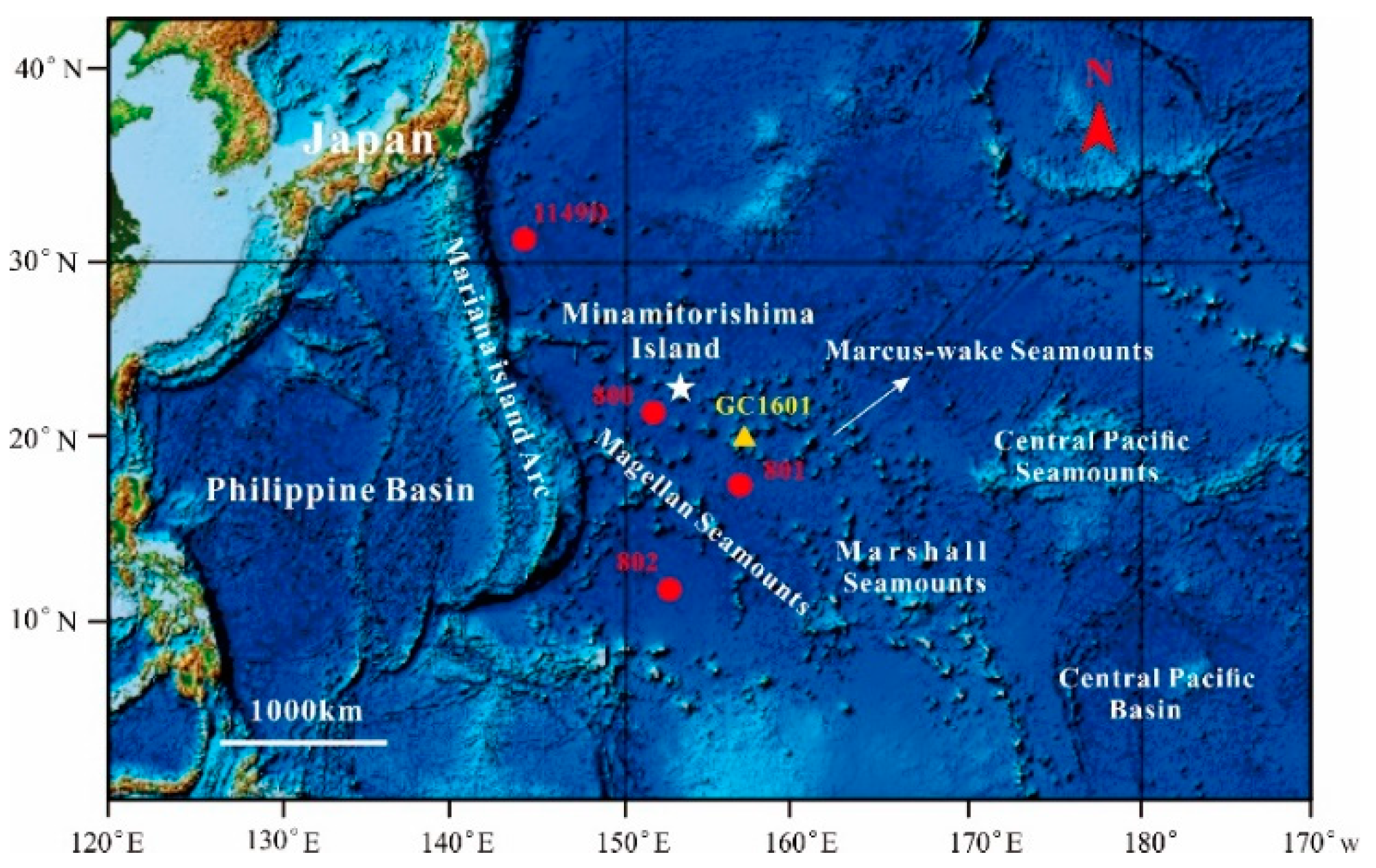

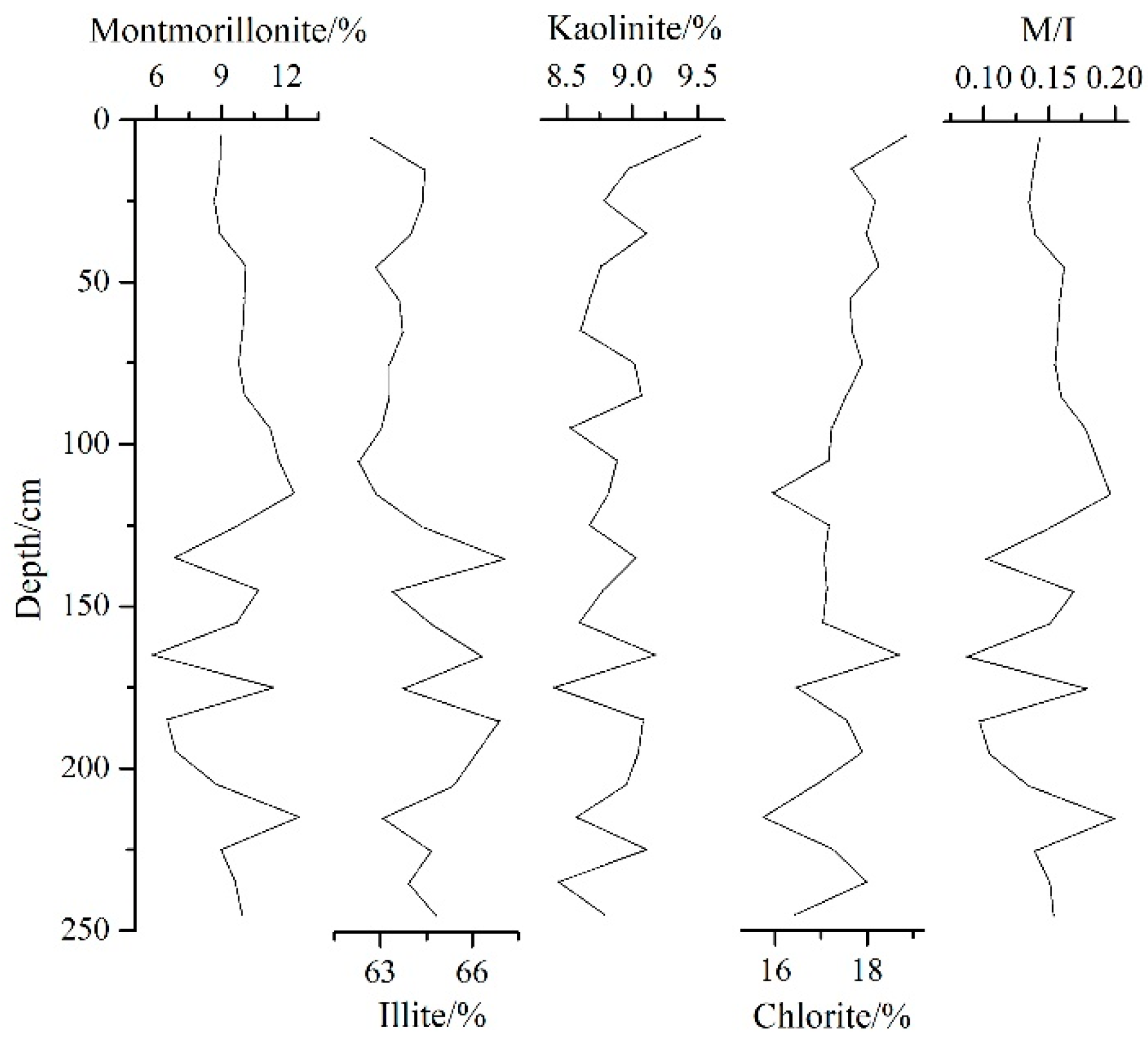
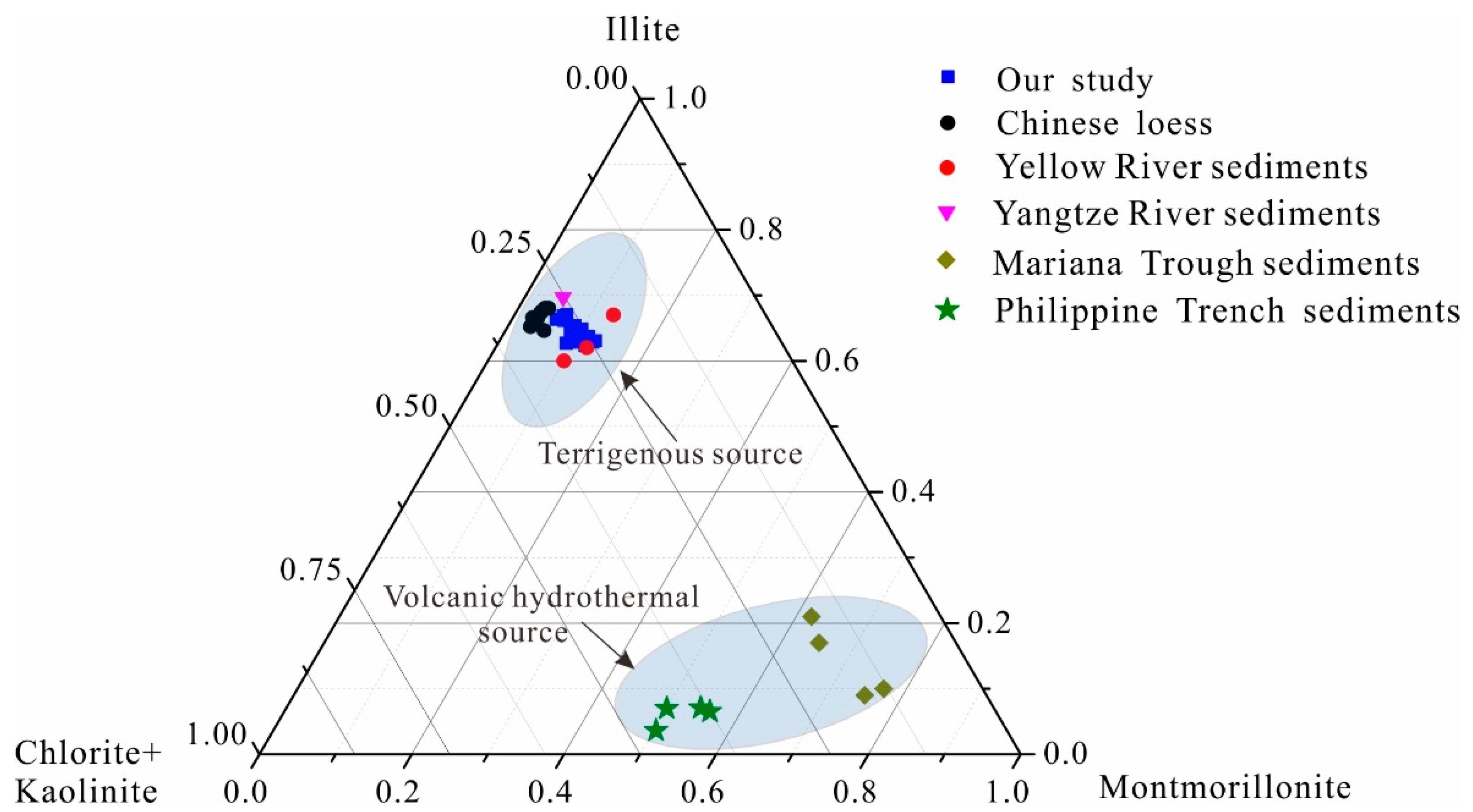
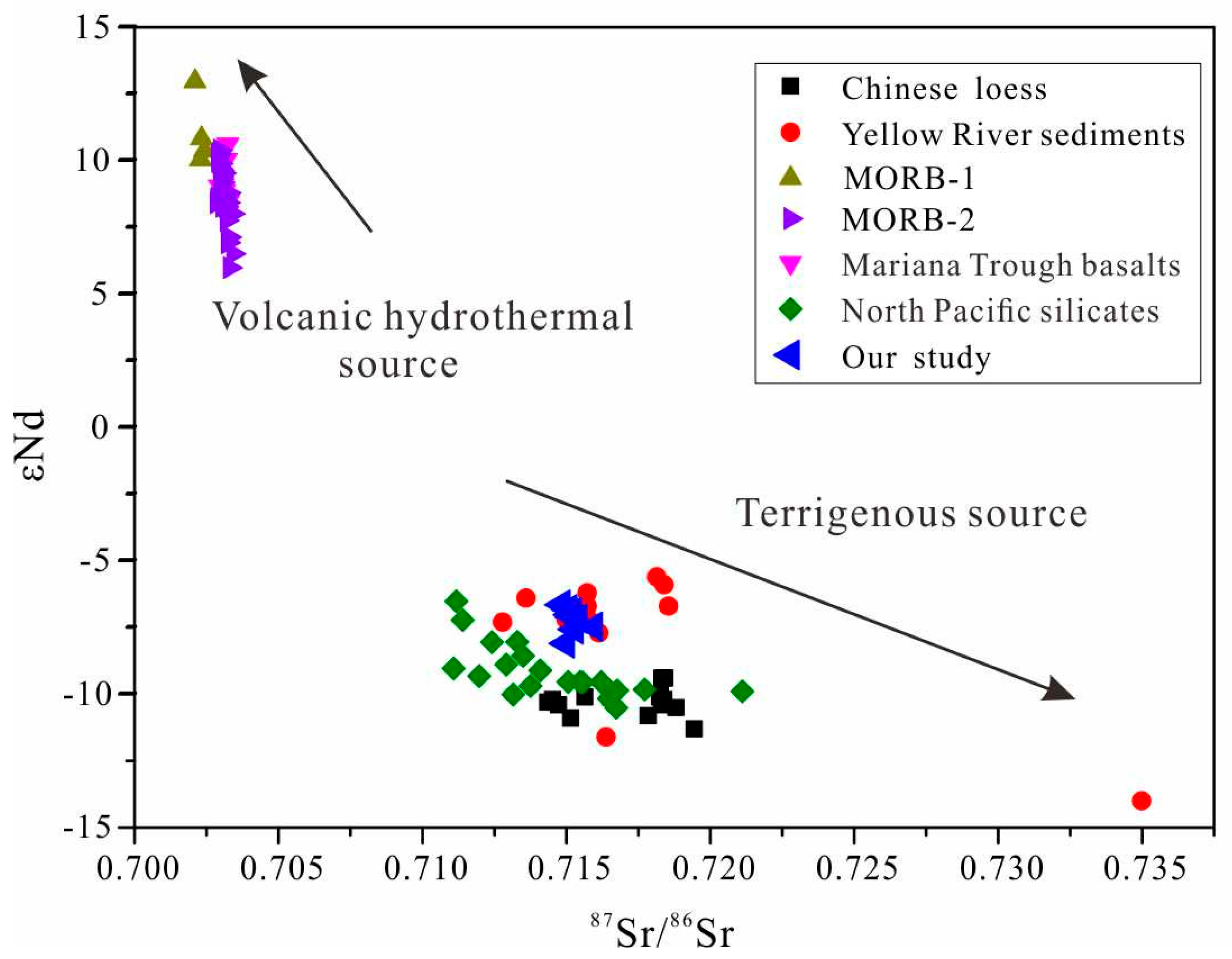
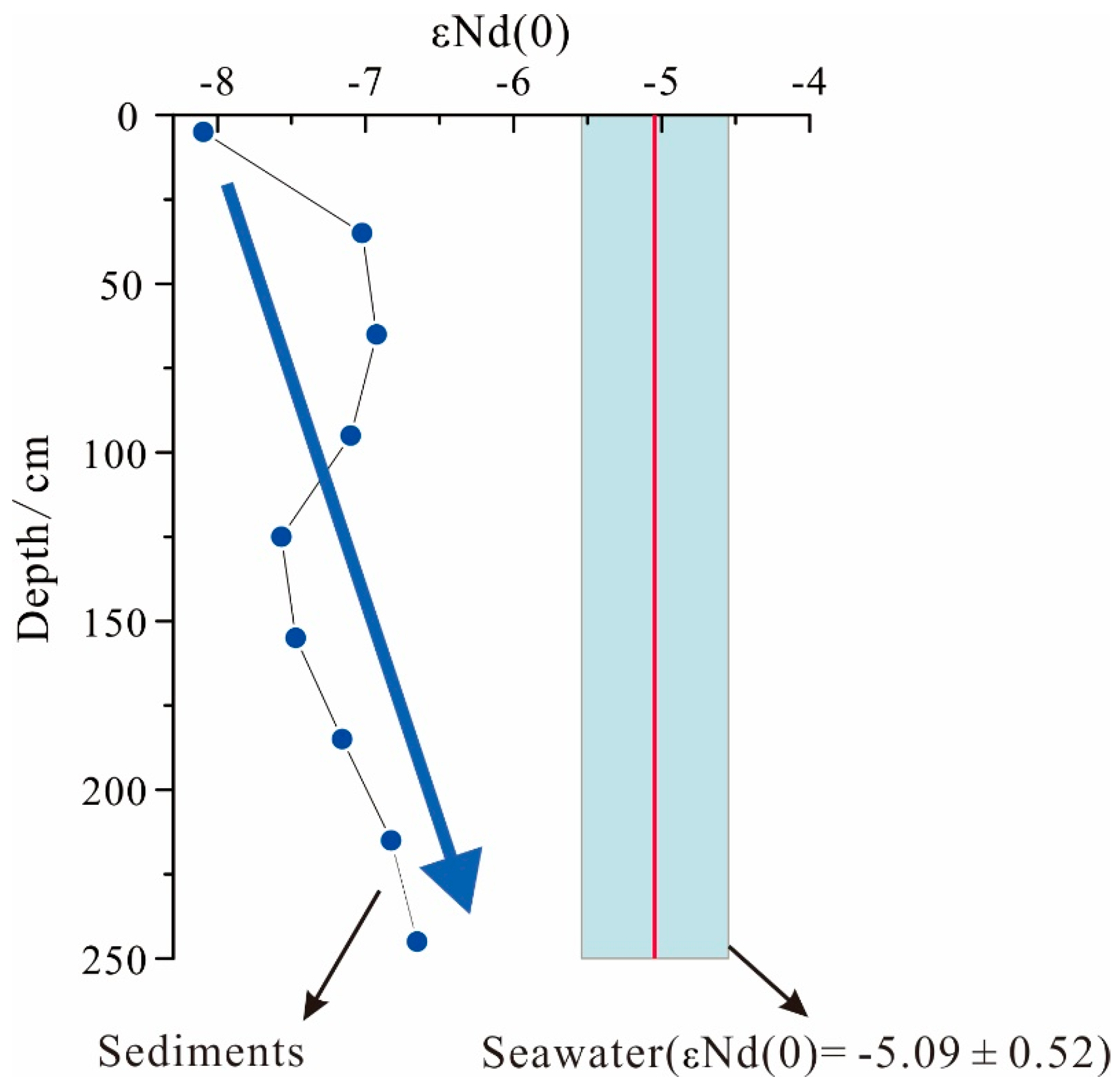

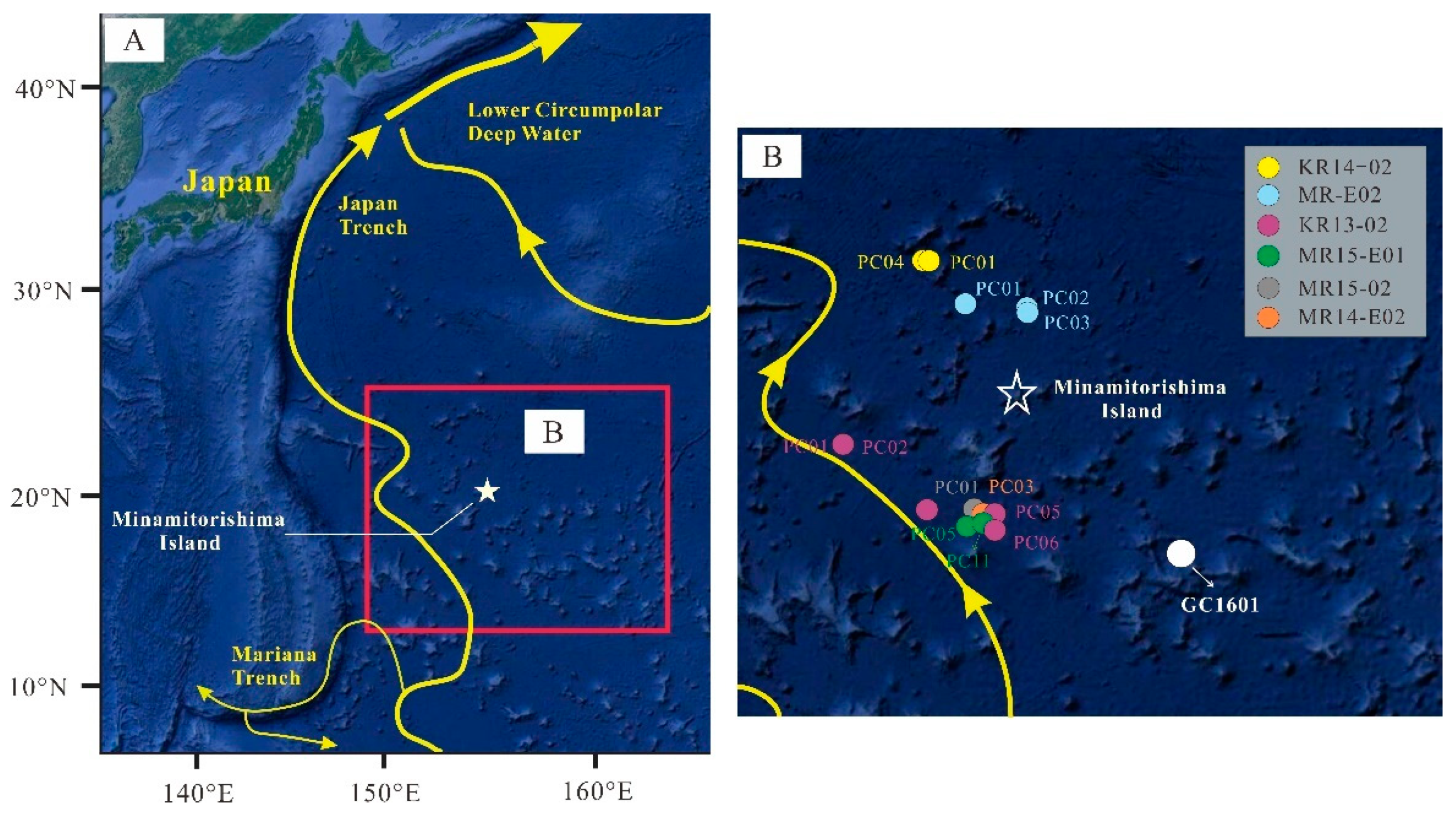
| Layer/cm | Relative Content of Clay Minerals (%) | M/I | Illite | ||||
|---|---|---|---|---|---|---|---|
| Montmorillonite | Illite | Kaolinite | Chlorite | CI | Crystallinity | ||
| 0–10 | 9.0 | 63 | 9.5 | 18.8 | 0.14 | 0.39 | 0.29 |
| 10–20 | 8.9 | 64 | 9.0 | 17.7 | 0.14 | 0.36 | 0.28 |
| 20–30 | 8.7 | 64 | 8.8 | 18.2 | 0.13 | 0.40 | 0.28 |
| 30–40 | 8.9 | 64 | 9.1 | 18.0 | 0.14 | 0.42 | 0.29 |
| 40–50 | 10.1 | 63 | 8.8 | 18.3 | 0.16 | 0.45 | 0.28 |
| 50–60 | 10.1 | 64 | 8.7 | 17.6 | 0.16 | 0.39 | 0.28 |
| 60–70 | 10.0 | 64 | 8.6 | 17.7 | 0.16 | 0.42 | 0.28 |
| 70–80 | 9.8 | 63 | 9.0 | 17.9 | 0.15 | 0.41 | 0.27 |
| 80–90 | 10.1 | 63 | 9.1 | 17.6 | 0.16 | 0.42 | 0.28 |
| 90–100 | 11.2 | 63 | 8.5 | 17.2 | 0.18 | 0.40 | 0.28 |
| 100–110 | 11.7 | 62 | 8.9 | 17.2 | 0.19 | 0.42 | 0.27 |
| 110–120 | 12.4 | 63 | 8.8 | 16.0 | 0.20 | 0.42 | 0.29 |
| 120–130 | 9.8 | 64 | 8.7 | 17.2 | 0.15 | 0.42 | 0.28 |
| 130–140 | 6.8 | 67 | 9.0 | 17.1 | 0.10 | 0.43 | 0.29 |
| 140–150 | 10.7 | 63 | 8.8 | 17.1 | 0.17 | 0.40 | 0.27 |
| 150–160 | 9.7 | 65 | 8.6 | 17.0 | 0.15 | 0.43 | 0.28 |
| 160–170 | 5.8 | 66 | 9.2 | 18.7 | 0.09 | 0.44 | 0.27 |
| 170–180 | 11.4 | 64 | 8.4 | 16.5 | 0.18 | 0.41 | 0.28 |
| 180–190 | 6.5 | 67 | 9.1 | 17.6 | 0.10 | 0.46 | 0.28 |
| 190–200 | 6.9 | 66 | 9.0 | 17.9 | 0.10 | 0.41 | 0.27 |
| 200–210 | 8.8 | 65 | 9.0 | 16.9 | 0.13 | 0.42 | 0.28 |
| 210–220 | 12.6 | 63 | 8.6 | 15.7 | 0.20 | 0.41 | 0.28 |
| 220–230 | 9.0 | 65 | 9.1 | 17.3 | 0.14 | 0.42 | 0.27 |
| 230–240 | 9.6 | 64 | 8.4 | 18.0 | 0.15 | 0.44 | 0.26 |
| 240–250 | 9.9 | 65 | 8.8 | 16.4 | 0.15 | 0.45 | 0.28 |
| Max | 12.6 | 67 | 9.5 | 18.8 | 0.20 | 0.46 | 0.29 |
| Min | 5.8 | 62 | 8.4 | 15.7 | 0.09 | 0.36 | 0.26 |
| Average | 9.5 | 64 | 8.9 | 17.4 | 0.15 | 0.42 | 0.28 |
| No | Layer/cm | 87Sr/86Sr | 2σ/ × 10−6 | 147Sm/144Nd | 143Nd/144Nd | 2σ/ × 10−6 | εNd(0) |
|---|---|---|---|---|---|---|---|
| N1 | 0–10 | 0.714976 | 4 | 0.131819 | 0.512223 | 6 | −8.10 |
| N2 | 30–40 | 0.715124 | 5 | 0.125666 | 0.512278 | 6 | −7.02 |
| N3 | 60–70 | 0.715230 | 4 | 0.122499 | 0.512283 | 7 | −6.92 |
| N4 | 90–100 | 0.715180 | 4 | 0.127205 | 0.512274 | 5 | −7.10 |
| N5 | 120–130 | 0.715281 | 4 | 0.128368 | 0.512250 | 7 | −7.57 |
| N6 | 150–160 | 0.715949 | 4 | 0.123743 | 0.512255 | 7 | −7.47 |
| N7 | 180–190 | 0.715415 | 4 | 0.120971 | 0.512271 | 9 | −7.16 |
| N8 | 210–220 | 0.715062 | 4 | 0.128217 | 0.512288 | 6 | −6.83 |
| N9 | 240–250 | 0.714828 | 4 | 0.130350 | 0.512297 | 7 | −6.65 |
| Average | 0.715227 | 4 | 0.126538 | 0.512269 | 7 | −7.20 | |
| Max | 0.715949 | 5 | 0.131819 | 0.512297 | 9 | −6.65 | |
| Min | 0.714828 | 4 | 0.120971 | 0.512223 | 5 | −8.10 | |
Publisher’s Note: MDPI stays neutral with regard to jurisdictional claims in published maps and institutional affiliations. |
© 2022 by the authors. Licensee MDPI, Basel, Switzerland. This article is an open access article distributed under the terms and conditions of the Creative Commons Attribution (CC BY) license (https://creativecommons.org/licenses/by/4.0/).
Share and Cite
Qiu, Z.; Ma, W.; Tao, C.; Koschinsky, A.; Hu, S. Clay Minerals and Sr-Nd Isotope Compositions of Core CG 1601 in the Northwest Pacific: Implications for Material Source and Rare Earth Elements Enrichments. Minerals 2022, 12, 287. https://doi.org/10.3390/min12030287
Qiu Z, Ma W, Tao C, Koschinsky A, Hu S. Clay Minerals and Sr-Nd Isotope Compositions of Core CG 1601 in the Northwest Pacific: Implications for Material Source and Rare Earth Elements Enrichments. Minerals. 2022; 12(3):287. https://doi.org/10.3390/min12030287
Chicago/Turabian StyleQiu, Zhongrong, Weilin Ma, Chunhui Tao, Andrea Koschinsky, and Siyi Hu. 2022. "Clay Minerals and Sr-Nd Isotope Compositions of Core CG 1601 in the Northwest Pacific: Implications for Material Source and Rare Earth Elements Enrichments" Minerals 12, no. 3: 287. https://doi.org/10.3390/min12030287
APA StyleQiu, Z., Ma, W., Tao, C., Koschinsky, A., & Hu, S. (2022). Clay Minerals and Sr-Nd Isotope Compositions of Core CG 1601 in the Northwest Pacific: Implications for Material Source and Rare Earth Elements Enrichments. Minerals, 12(3), 287. https://doi.org/10.3390/min12030287







